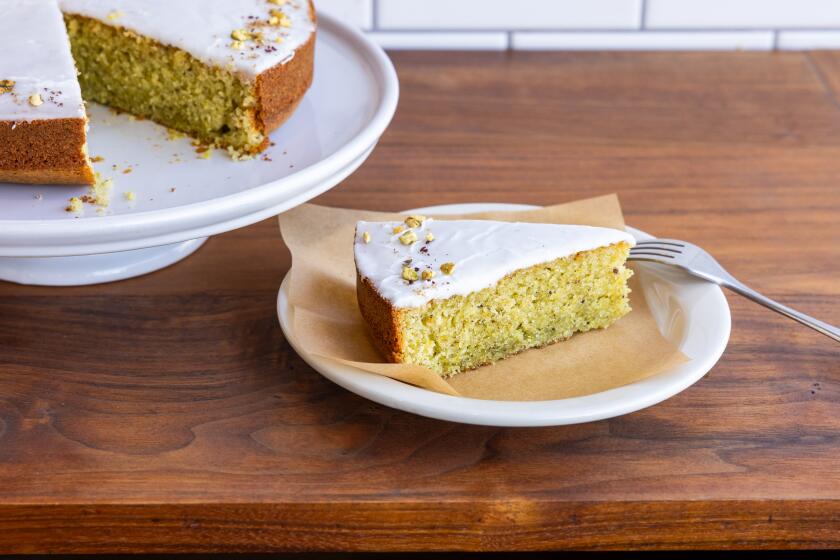Sandwiches : No Bad Bites: Sandwiches in the Modern Age
- Share via
In the bad old days, a poor workman could lunch on a chunk of good bread, smelling of the earth and golden grain, with a sweet onion or cheese, or a chewy slice of sausage or lean country ham, and a draft of real beer or cider or homemade wine. Talk of variety--how many hundreds of delicious varieties there were! Talk of convenience--what could be more simple to prepare than such a meal? And yet that workman was eating better than a Wall Street broker can today at Delmonico’s, with its stock ticker in the bar clattering the prices of the conglomerates that feed us now.
--John and Karen Hess, “The Taste of America” The Hesses published those words in 1977. Their book was an attempt to jolt Americans into recapturing the joy of good eating, and the state of the American sandwich was just one of their targets.
Fourteen years and a food revolution later, things have gotten . . . well, a little better. Wonder Bread, processed cheese slices and vacuum-packed meat products are still what most American sandwiches are made of, but a lot of Americans are rediscovering what their pre-convenience-food ancestors knew: Good ingredients make good sandwiches.
So do good chefs.
“We’re definitely big sandwich people,” says Susan Feniger, chef and co-owner of L.A.’s City Restaurant and Border Grills. “Part of our philosophy about food is to take simple things and just make them really delicious. There’s no reason a sandwich can’t be ‘up there’ on the menu with other entrees.”
Feniger and her partner, Mary Sue Milliken, are not alone. According to National Restaurant Assn. statistics, the number of sandwiches on restaurant menus rose 56% from 1985 to 1990. At Alice Water’s Cafe Fanny in Berkeley, for instance, egg salad is served on good, crusty bread and garnished with anchovies and sundried tomato strips. Judy Rodgers at San Francisco’s Zuni Cafe makes tuna sandwiches with seared ahi and capers and Nicoise olives. Anne Rosenzweig dresses up her club sandwich at New York’s Arcadia, with lobster, applewood smoked bacon and mixed greens. And every afternoon Michael Roberts serves modern finger sandwiches for tea at Trumps, in West Hollywood.
“I think people tend to be more creative with sandwiches than with anything else,” says chef and cookbook author Evan Kleiman of L.A.’s Angeli restaurants, where several versions of panini are served. “The sandwich is such a familiar format that people are willing to take more risks. You need a bread vehicle and some sort of moisturizing vehicle--mayo or butter or oil--and then it’s whatever you want.”
For home cooks, and especially for the non-cooking midnight snacker, a great sandwich can be as simple as jam and good, crunchy peanut butter on fresh wheat bread. Another person’s perfect sandwich: folding a piece of crusty bread around a bit of Parma prosciutto, then swirling it in a little extra-virgin olive oil. And there’s always the everything-you-can-find-in-the-refrigerator sandwich.
“We all grew up with the image of Dagwood,” Kleiman says. “That idea of just making layers and layers and putting things together--it’s really appealing.”
Chefs’ sandwiches can get more complicated. At City Restaurant, for instance, the Dagwood complex is the prevailing aesthetic.
“Our sandwiches are pretty intensive,” Feniger admits.
“To make a club sandwich,” Milliken says, “we use six pieces of grilled bread with mustard, mayonnaise and fresh horseradish on every single surface.”
“Our grilled chicken sandwich has horseradish-mustard on one side,” Feniger says, “lettuce and baba ghannuj on the other, then tomato with cracked-pepper vinegar . . . “
“We’re really building sandwiches, with lots of flavors in every corner,” Milliken says. “I always hear Susan bugging the kitchen staff: ‘I don’t want anybody thinking that only that middle bite of the sandwich is the good one. I want the edge bite to be really good, too.’ ”
“I hate eating around to the middle bite,” Feniger says. “And I can’t stand to eat a sandwich and have it be just sort of . . .
”. . . for sustenance,” Milliken breaks in.
Milliken and Feniger talk about sandwiches the way old friends reminisce over a photo album.
“I love the pate sandwich,” Feniger says. “We should do that one again.”
“My favorite is salami,” Milliken says. “ Mmmmm .”
“I know,” Feniger smiles.
“And remember that fabulous salmon sandwich we were doing?” Milliken asks.
“Oh, yeah, Feniger says, “that was a great sandwich.”
“You know,” Milliken says, “we really have done a lot of sandwiches.”
More to Read
Eat your way across L.A.
Get our weekly Tasting Notes newsletter for reviews, news and more.
You may occasionally receive promotional content from the Los Angeles Times.











